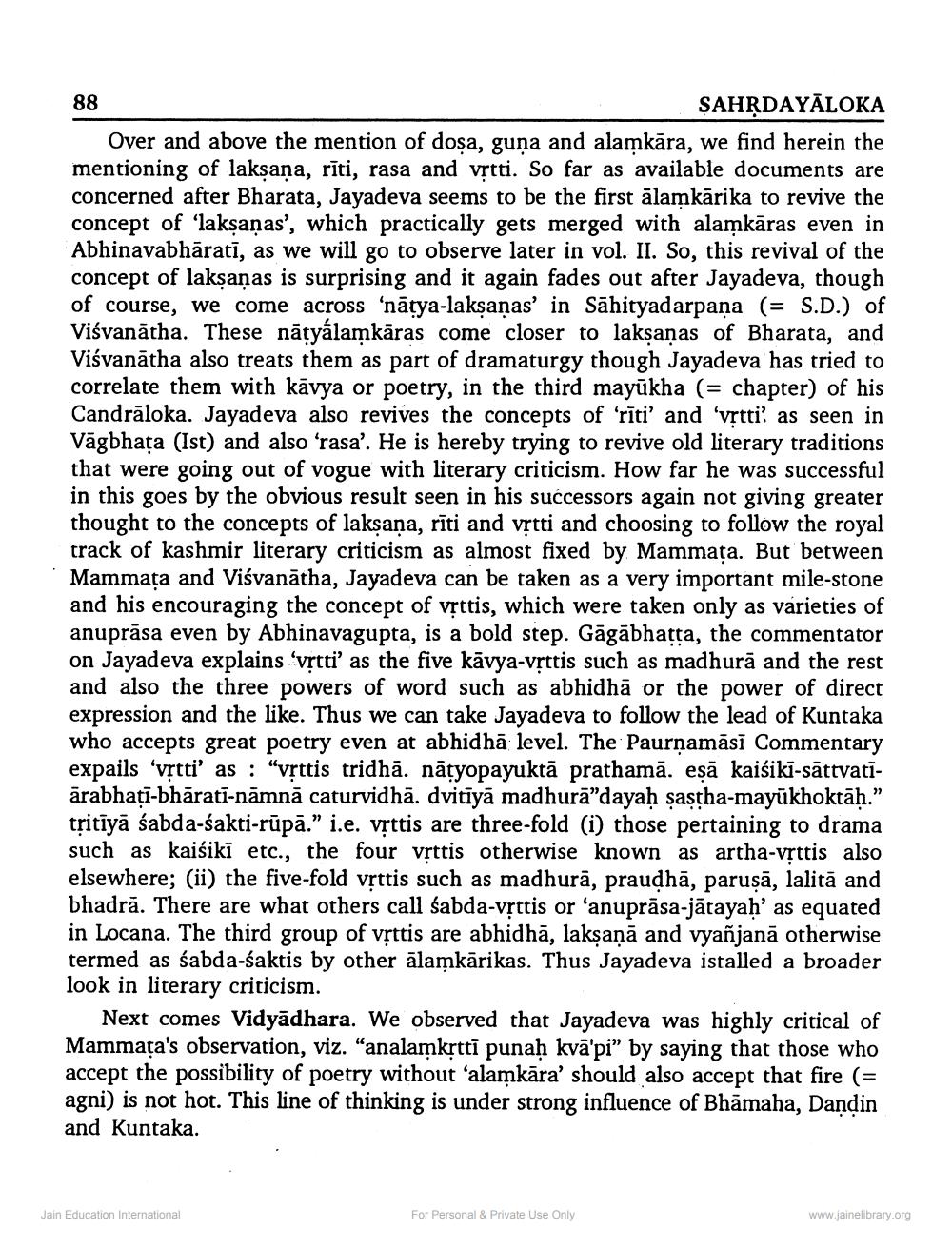________________
88
SAHRDAYĀLOKA
Over and above the mention of dosa, guna and alamkāra, we find herein the mentioning of laksana, rīti, rasa and vstti. So far as available documents are concerned after Bharata, Jayadeva seems to be the first ālamkārika to revive the concept of 'laksanas', which practically gets merged with alamkāras even in Abhinavabhāratī, as we will go to observe later in vol. II. So, this revival of the concept of laksanas is surprising and it again fades out after Jayadeva, though of course, we come across 'nātya-laksaņas' in Sāhityadarpana (= S.D.) of Viśvanātha. These nātyalamkāras come closer to laksanas of Bharata, and Viśvanātha also treats them as part of dramaturgy though Jayadeva has tried to correlate them with kāvya or poetry, in the third mayūkha (= chapter) of his Candrāloka. Jayadeva also revives the concepts of 'rīti' and 'vrtti? as seen in Vāgbhata (Ist) and also 'rasa'. He is hereby trying to revive old literary traditions that were going out of vogue with literary criticism. How far he was successful in this goes by the obvious result seen in his successors again not giving greater thought to the concepts of laksana, rīti and vrtti and choosing to follow the royal track of kashmir literary criticism as almost fixed by Mammata. But between Mammata and Viśvanātha, Jayadeva can be taken as a very important mile-stone and his encouraging the concept of vịttis, which were taken only as varieties of anuprāsa even by Abhinavagupta, is a bold step. Gāgābhatta, the commentator on Jayadeva explains 'vrtti' as the five kavya-vșttis such as madhurā and the rest and also the three powers of word such as abhidhā or the power of direct expression and the like. Thus we can take Jayadeva to follow the lead of Kuntaka who accepts great poetry even at abhidhā level. The Paurnamāsī Commentary expails 'vrtti' as : "vrttis tridhā. nātyopayuktā prathamā. esā kaisiki-sātrvatiārabhati-bhārati-nāmnā caturvidhā. dvitiya madhurā"dayah sastha-mayükhoktāh." tritīyā śabda-śakti-rūpā." i.e. vịttis are three-fold (i) those pertaining to drama such as kaiśiki etc., the four vrttis otherwise known as artha-vrttis also elsewhere; (ii) the five-fold vrttis such as madhurā, praudhā, parusā, lalitā and
are what others call sabda-vrttis or 'anuprāsa-jātayah' as equated in Locana. The third group of vrttis are abhidhā, laksaņā and vyañjanā otherwise termed as sabda-śaktis by other ālamkārikas. Thus Jayadeva istalled a broader look in literary criticism.
Next comes Vidyadhara. We observed that Jayadeva was highly critical of Mammata's observation, viz. "analamkrtti punah kvā'pi" by saying that those who accept the possibility of poetry without 'alamkāra' should also accept that fire (= agni) is not hot. This line of thinking is under strong influence of Bhāmaha, Dandin and Kuntaka.
Jain Education International
For Personal & Private Use Only
www.jainelibrary.org




